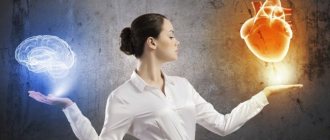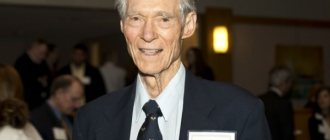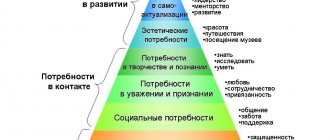Psychological theories of emotion
Numerous physiological changes in the body are accompanied by any emotional state. Throughout the history of the development of this area of psychological knowledge, attempts have been made to connect physiological changes in the body with certain emotions and to show that the complexes of organic signs accompanying various emotional processes are in fact different.
Vasiliev I.A. The article “Humanitarian and natural science paradigms in the study of emotions” criticizes the natural science approach to the study of emotions. The problem of isolating connections and relationships and proving their existence or absence is formulated. The problem of the method of studying emotions is raised.
In 1872, C. Darwin published the book “The Expression of the Emotions in Man and Animals,” which became a turning point in understanding the connection between biological and psychological phenomena, in particular, between the body and emotions. In it, he showed that the evolutionary principle can be applied not only to the biophysical, but also to the psychological and behavioral development of living beings, and that there is no insurmountable gap between the behavior of animals and humans. Darwin showed that great apes and blind children have much in common in the outward expression of various emotional states and expressive body movements. These observations formed the basis of a theory of emotions called the theory of evolution. According to this theory, in the process of evolution of living beings, emotions appear as vital adaptive mechanisms that help the body adapt to the conditions and situations of its life. According to Darwin, the physical changes that accompany various emotional states, such as the movements associated with the corresponding emotions, are no more than rudiments of the body's actual adaptive responses.
Darwin's ideas. Darwin's ideas were taken and developed into another theory that became widely known in psychology. Its authors were W. James and K. Lange. Jacob believed that certain bodily states were characterized by different emotions—curiosity, delight, fear, anger, and excitement. The corresponding physical changes were called organic manifestations of emotions. It is organic changes, according to the James-Lange theory, that are the causes of emotions. Reflected through a feedback system in the human mind, they produce an emotional experience of the corresponding modality. First, under the influence of external stimuli, changes characteristic of emotions occur in the body, and only then, as a consequence, does the emotion itself arise.
An alternative view on the parity of organic and emotional processes was proposed by W. Cannon. He was one of the first to point out that the bodily changes observed during the occurrence of various emotional states are quite similar to each other and are insufficient in their diversity to satisfactorily explain the qualitative differences in the highest emotional experiences of a person. Moreover, the internal organs, with changes in the state of which James and Lange associate the emergence of emotional states, are rather insensitive structures that become excited only very slowly. Emotions, on the other hand, usually arise and develop quite quickly.
Cannon's strongest counterargument to James Lang's theory was that artificially induced interruption of organic signals to the brain does not prevent the emergence of emotions.
The psychoorganic theory of emotions (the concepts of James Lange and Cannon-Bard can only be called conditionally) was further developed under the influence of electrophysiological studies of the brain. On its basis, the Lindsay-Hebb activation theory was formed. According to this theory, emotional states are determined by the influence of the reticular formation of the lower part of the brain stem. Emotions arise when balance is disturbed and restored in the corresponding structures of the central nervous system. Activation theory is based on the following basic principles:
- The electroencephalographic pattern of brain functioning that occurs during emotions is an expression of the so-called “activation complex” associated with the activity of the reticular formation.
- The work of the reticular formation determines many dynamic parameters of emotional states: their strength, duration, variability and a number of others.
Following theories that explain the connection between emotional and organic processes, theories have emerged that describe the influence of emotions on the human psyche and behavior. It has been established that emotions regulate activity and have a certain influence on it, depending on the nature and intensity of the emotional experience. MIN.O. Hebb was able to experimentally obtain a curve expressing the relationship between the degree of emotional arousal of a person and the success of his practical activity.
Too weak and very strong emotional arousal is undesirable for achieving the highest results in activity. For each person (and for all people in general) there is an optimal level of emotional arousal, which ensures maximum efficiency at work. The optimal level of emotional arousal, in turn, depends on many factors: the characteristics of the activity in which we are engaged, the conditions in which it occurs, the individuality of the person involved in it, and much more. Too little emotional arousal does not provide adequate motivation for activity, while too much emotional arousal destroys it, disorganizes it and makes it practically uncontrollable.
In humans, cognitive-psychological factors (cognitive means - knowledge) play no less important role in the dynamics of emotional processes and states than organic and physical influences. In this context, new concepts have been proposed to explain human emotions through the dynamic features of cognitive processes.
One of the first such theories was the theory of cognitive dissonance by L. Festinger. According to this theory, a person experiences positive emotions when his expectations are confirmed and his knowledge is realized, i.e. when the actual results of actions correspond, are consistent, or, which is the same thing, correspond to expectations. Negative emotions arise and intensify when there is inconsistency, inconsistency, or dissonance between the expected and actual results of actions.
Subjectively, a person usually perceives a state of cognitive dissonance as discomfort, and he strives to get rid of it as quickly as possible. The way out of the state of cognitive dissonance can be twofold: either change cognitive expectations and plans so that they coincide with the actually achieved result, or try to achieve a new result that would coincide with previous expectations. In modern psychology, the theory of cognitive dissonance is often used to explain human actions and behavior in various social situations. Emotions are considered the main motive for corresponding actions and actions. The underlying cognitive factors are considered to play a much greater role in determining human behavior than organic changes.
The predominant cognitive orientation of modern psychological research has led to the inclusion in people's consciousness of assessments of situations as motiogenic factors. It is believed that such assessments directly influence the nature of emotional experiences.
Regarding the conditions and factors for the emergence of emotions and their dynamics, contributions were made by W. James, K. Lange, W. Cannon, P. Bard, D. Hebb and L. Festinger, S. Schechter. He showed that memory and human motivation are fundamental components of emotional processes. The concept of emotions, developed by S. Schechter, is called cognitive-physiological.
According to this theory, in addition to perceived stimuli and the physical changes they produce, the emotional state that arises is also influenced by a person's previous experiences and his assessment of the current situation in terms of interests and needs that are relevant to him. Indirect confirmation of the validity of the cognitive theory of emotions is the influence of verbal instructions on human experience, as well as additional emotogenic information that should change a person’s assessment of the situation.
In one experiment designed to prove the claims of the cognitive theory of emotion, people were given a physiologically neutral solution with various instructions as “medicine.” In one case, they were told that the “drug” would make them euphoric, in the other, anger. After taking the “drug,” subjects were asked how they would feel after a certain period of time if they were given instructions to take the drug. It was found that the emotional feelings they reported were similar to those they expected to experience after being given the instructions.
It has also been shown that the nature and intensity of a person’s emotional experiences in a given situation depends on how others experience him. This means that emotional states can be transmitted from person to person, and that in humans, unlike animals, the quality of the transmitted emotional experiences depends on the personal relationship with the empathetic person.
Strength of feelings
The strength of feelings distinguishes a person living a vibrant life from the gray crowd around him. It’s much easier to impress a melancholic homebody than someone who prefers risky hobbies.
If a person constantly lies in bed and does nothing, even minor events will cause a great response in him. In a busy life, the same circumstances may not provoke any emotions.
The strength of feelings is determined by the height of the barriers that a person overcomes. To be convinced, it is enough to consider a simple example: hunger. When a person, even with slight discomfort, immediately goes to have a snack, the food does not cause any emotional reaction in him. He doesn't attach any importance to this event.
If before this a person was on a long hike or returned home after a long work shift, he will receive great pleasure even from a simple dish.
The difference is due to discomfort. Positive emotions arise from sharp contrasts. This also works with long wait: if a person works on something for a long time, he will be happy when he gets the result. However, there is a danger here. If the effort expended does not match the result, dissatisfaction and even frustration will arise.
The main skill of happy people is the ability to set adequate goals for themselves. They must be large enough and difficult enough to create contrast. However, you should not overexert yourself or put in a lot of effort with minimal results. The difficulty must match the reward.
For this reason, you cannot immediately move on to intimacy if you want to build a long-term relationship. Sex is the result of action. If there has been no action yet, the person will not perceive what happened as a new height. The strength of his feelings will not increase. On the contrary, it will consolidate at a low level.
A more profitable tactic in this case would be flirting, inciting passion and at the same time restraining it. The greatest response will be caused by moving to the next level at the peak of feelings.
It is important not to overdo it, because a long absence of relationship development causes fading of emotions and boredom. Given the existing frustration, it will be impossible to stop this process.
Light flirting can develop into a great fire of passion.
Psychology of emotions in the Concept of L.S. Vygotsky
L.S. Vygotsky did not leave a complete doctrine of emotions. At the same time, in a number of his works one can find quite detailed arguments on this problem. Taken together, they present a fairly complete picture of Vygotsky’s ideas about the nature and mechanisms of development of human emotions. Philosophically, these ideas are based on the ideas of Spinoza and, in particular, on his principle of the unity of affect and intellect. Vygotsky's predecessor in the development of this principle in psychological science is Kurt Lewin. The main points of Vygotsky's approach to the problem of emotions are as follows.
1. emotions develop. Based on this, each emotion should be classified only from the point of view of its development.
2. there is a connection between affect and intelligence. Each stage in the development of thought corresponds to a stage in the development of affect. The development of thoughts and feelings comes from one root, the infant's affective action. Further development of affect continues: 1) along the path of differentiation of the emotional sphere of consciousness with subsequent differentiation within this sphere itself; 2) in the direction of changing the nature of dynamic processes. Both are directly related to the development of thought.
Thus, if in early childhood the child’s behavior can be characterized as a “field”, and consciousness is characterized by a single affective perception and action, then the main symptom of the crisis of the 3rd year is a violation of the unity of affect and action. The child does not act directly under the influence of passion, but acts contrary to his inclination. As the child’s visually actual thinking gives way to figurative thinking, the affective side of consciousness also develops. This is reflected, first of all, in the generalization of internal processes, which is one of the significant aspects of changes in preschool age. During this period, a generalization of feelings occurs: An affective formation arises that connects a single affect as a concept with a single perception. Finally, during adolescence, the formation of thinking in terms of concepts leads to deeper knowledge and ordering of one's world of experience.
Another aspect of changes in the affective sphere of a person is related to the fact that each stage of the development of thought corresponds to a certain nature of dynamic processes. Vygotsky notes that concrete thought corresponds to more skeletal and rigid dynamics, while abstract thought and imagination correspond to smoother and more flexible dynamics. In this regard, the qualitative specificity of higher or subtle emotions becomes obvious. The differentiation of emotions and their softer course are a direct consequence of the development of thought.
3 In addition to the influence of thought on affect, there is also a reverse influence of affect on thought. This is especially obvious: 1) each idea contains, in a revised form, a person’s affective attitude towards the reality represented in this idea; 2) thinking itself comes from the motivational sphere of our consciousness. According to Vygotsky, the relationship of thought to word is a living process, “movement through a whole series of internal planes.”
4. in pathology (for example, schizophrenia), the damage to the intellectual or emotional aspects of consciousness as such is usually less than the pathological change in their correlation.
Vygotsky advocates the principle of active participation of emotions in the overall development of consciousness. It affects not only the development of the child’s thinking and behavior, but is also a powerful incentive that encourages the child to seek “developmental deviations” in the presence of a birth defect.
6. activity plays an important role in the development of a person’s emotional sphere. Activity can influence indirectly (activity mainly develops thinking, which, in turn, causes changes in the affective sphere) and directly, as happens, for example, in a child’s play activity.
7. The development of the affective sphere follows the same logic as the development of other mental functions. The development of emotions goes in the direction of consciousness.
8. Every emotion is a function of personality.
Ideas L.S. Vygotsky’s ideas about the nature of emotions and their development form an integral part of his concrete psychological theory of consciousness.
What is emotionality
In psychology, emotionality characterizes the quality, content and dynamics of emotions. It can be strong when emotions are clearly expressed, or it can be weak when an event leaves no trace in a person’s soul or when this trace is not noticeable to others.
People who are far from psychology understand emotionality as emotions expressed clearly and noticeably to others. A person with direct, living perception is called emotional.
Information theory of emotions
This approach to the problem of emotions fully belongs to the Pavlovian direction in modifying the higher nervous activity of the brain.
When Pavlov formulated his research strategy, he argued that it was important to first understand psychologically and then translate into physiological language. He did not deny psychology as knowledge of the inner world of man, but defended the absolute right of natural scientific thought everywhere and as long as it develops its power.
The information theory of emotions is a doctrine of higher nervous activity of the brain, founded by I.P. Pavlov. This is not traditional brain physiology or psychology, since it represents a qualitatively new field of knowledge based on a systemic view of the psyche and behavior.
The essence of the approach: capturing both sides of the psyche - its neurophysiological mechanisms and reflexive-regulatory functions, its correlation with the needs of the body (person) and the surrounding world.
When studying the influence of emotions on activity, the importance of the quality of the need on the basis of which the emotional state arises was revealed. The question of whether the need was caused by any specific activity or by an extraneous motive that gives rise to emotions is extremely important here.
In his work, physiologist I.P. Pavlov pointed out factors that are inseparable from the involvement of the brain mechanisms of emotion.
These are the inherent needs and drives of the body, which Pavlov identified with innate (unconditioned) reflexes. However, Pavlov understood that the diversity of human emotions cannot be reduced to innate (unconditioned) reflexes. Pavlov discovered a mechanism by which the brain apparatus, responsible for the formation and implementation of emotions, is involved in the process of conditioned reflex activity (behavior) of higher animals and humans.
Based on experiments devoted to the phenomenon of systemic or dynamic stereotypy in the work of the cerebral hemispheres, Pavlov concluded that under the influence of external stereotypy of repeated influences, a stable system of internal processes is formed in the cerebral cortex. According to Pavlov, the processes described in the great hemispheres correspond to what we subjectively in us usually call feelings, in the general form of positive and negative feelings, and in a large number of shades and variations arising either as a result of their combination or as a result of various stress. Here you can feel difficulty and lightness, fun and fatigue, contentment and sadness, joy, victory and despair.
Sublimity of feelings
The second property of feelings is sublimity. It is determined by the rhythm of the brain centers and their coordination. The closer the body is to a state of harmony, the more sublime the feelings.
In practice, this is associated with contrasts and a complete list of experienced sensations. Physical feelings are most often base. They are associated with discomfort.
For example, a person experiences pleasure from eating food if he has recently been hungry, but at the same time he has a feeling of heaviness in his stomach.
Being able to relieve the itching brings relief, but it is mixed with discomfort. Prolonged abstinence from satisfying the need increases both discomfort and pleasure during the satisfaction of the need.
An example of sublime emotions is the feelings that a person experiences when listening to music. At this moment, no accompanying negativity arises, so all brain centers work in the same rhythm, in harmony. A person experiences complete pleasure, not spoiled by any negativity.
The basis of happiness is sublime feelings. First of all, they affect social relationships with loved ones. To understand whether you love a person, it is enough to analyze the situation and figure out whether anything makes you angry or irritated.
If, for example, you subconsciously blame your partner for something and are angry with him, it is better to immediately leave the relationship. You will not be able to restore what is already broken.
Broken relationships cannot be restored.
Classification
People can be very different from each other. They may live in different countries, be brought up according to different customs, but in most cases their emotions are similar. Animals have a unique ability to understand human emotions. For example, a cat or dog perfectly senses the owner’s mood. If a person is in a good mood, the animal will definitely approach him. Feeling the slightest sign of anger and aggression, the pet will try to stay away from the person.
Scientists cannot yet fully formulate a definition of this phenomenon. It is not clear exactly how animals feel hatred or joy coming from a person. However, almost every person can confirm this phenomenon.
Emotions are different and are divided into several types. They have the ability to quickly replace each other. A person can be depressed and suddenly regain vitality. An unusual surge of strength can also be replaced by apathy and a desire to hide from the world. Being sad and sorrowful, a person can suddenly become cheerful and joyful.
People have a hard time hiding their emotions. Often they are immediately reflected on a person’s face, and in order to avoid this, you need to have incredible control over yourself.
Trying to hide their true feelings, they can give themselves away with gestures, facial expressions, or even their voice.
In general, emotions can be divided into three main groups.
- Positive;
- Negative;
- Neutral;
Positive emotions include joy, laughter, happiness, pleasure, love, sympathy, admiration, bliss and others. They bring only positive feelings to a person and make his life much better.
Negative emotions usually include envy, anger, hatred, resentment, fear, disgust, regret and others. Such emotions drive a person into a depressed state and significantly worsen his life.
Neutral emotions include surprise, curiosity and indifference. Often such emotions do not carry any special subtext and are not of significant interest to a person.











